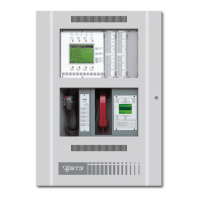Access control applications
EST3 Installation and Service Manual 3.7
The CRC can accommodate any PIN number of 1-4 digits along
with the associated card code. The need to enter a PIN is
controlled by two factors: whether or not the CRC is armed, and
whether or not the access schedule calls for use of a PIN.
Lock
The CRC supports any type of door locking or releasing device.
Common lock devices are strikes and maglocks. A strike opens
the door when power is supplied, while a maglock secures the
door while power is supplied.
RPM Resource Profile Manager tool
The Resource Profile Manager (RPM) tool is part of the SDU. It
uses the project database to let you create a separate resource
profile for each company that will be using the access control
system.
The resource profile defines the access control system for the
ACDB program. It includes detailed information about each
CRC used by a given company. For example:
• Communication method
• Primary or secondary control
• Number of cardholders
• Number of schedules
• Number of holidays
• Number of access levels
• Command lists used
ACDB Access Control Database program
The Access Control Database (ACDB) program lets you define
and maintain a database of information about CRCs, cardholders,
and access levels.
The ACDB program runs on the your PC. Additions or updates
to the access control database can be transmitted to the CRC
units in two ways.
The first method is via modem and dial-up telephone line to the
3-MODCOM. The information is then routed to the CPU,
through the correct 3-SACs, and finally to the CRC units.
The second method is by connecting your PC directly to the
CPU using an RS-232 cable. The connection is made between
the PC’s COM1 port and any of the RS-232 terminals on the
CPU. As in the first method, after reaching the CPU additions
and changes are routed through the correct 3-SACs to the CRCs.
Note: Changes to the access control database have no impact on
the parameters or operations of listed fire system equipment.

